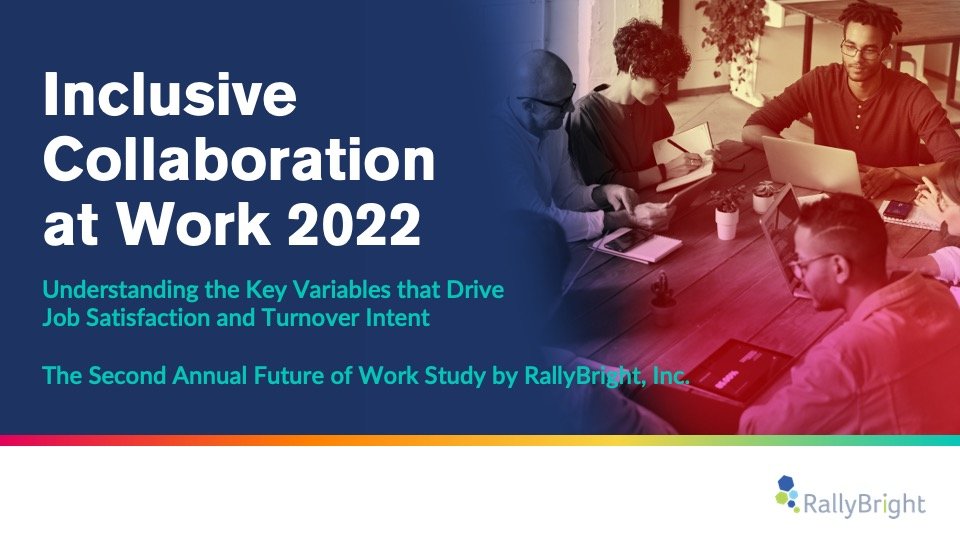Inclusion is not only the right thing for businesses to pursue. It’s good business. Gartner found that 75% of organizations with frontline decision-making teams with a diverse and inclusive culture exceed their financial targets. And, McKinsey found that companies in the top quartile for gender diversity on executive teams were 25% more likely to have above-average profitability than companies in the fourth quartile. Moreover, they found that the greater the representation, the higher the likelihood of outperformance.
But, how exactly does inclusion drive business performance? Our own RallyBright research tells us that inclusion impacts turnover intent by a whopping factor of ten: employees in highly inclusive workplaces are ten times less likely to think about leaving than their peers in low-inclusion workplaces, and 98% of them report being satisfied or very satisfied with their jobs. These markers of employee engagement tie directly to business impact., so, it’s worth examining how a systematic, business-focused approach to inclusion can contribute to overall business success.
With the help of D&I expert and certified executive coach Linda Singh, Ph.D., CEO of leadership consulting firm Kaleidoscope Affect LLC, we’ve identified several ways leaders can impact performance through inclusion strategies.

Take Bolder Action
Inclusion and diversity initiatives can be complex and take time to yield measurable results. But this should not be used as a reason to accept slow progress. Leaders who are responsible for advancing inclusion initiatives should take bold steps to move the needle.
Dr. Singh suggests companies can take bolder action by promoting inclusive behavior at all levels of the organization – from the most senior-level executive to the most junior entry-level worker. She explains, “Inclusive behavior characteristics should be embedded in company values and strategy, as well as down to each division and department to the individual level. Embedding inclusive behavior throughout the organization sets the foundation for an inclusive culture. I think we need to be bold enough at the senior levels to commit to creating a culture supported by inclusive behavior.”
Cultivate Employee Engagement
Engaged employees are highly productive, innovative and work hard to help their organizations achieve their goals. So, it makes sense to consider how your inclusion initiatives can help you drive better employee engagement.
Dr. Singh stresses the importance of reminding employees of “what right looks like,” and of their role in creating positive interpersonal exchanges. She explains, “Interpersonal dynamics and culture go hand-in-hand. Relationships, trust, and communication are at the heart of interpersonal dynamics. We tend to interact with others based on our own experiences, and those change over time. As such, creating positive interpersonal experiences in the workplace ultimately will foster employee engagement.”
In this way, inclusion can serve as a catalyst for engagement. In an inclusive environment, where everyone is treated fairly, feels respected and has equal access to opportunities, trust and connection develop, leading to the kind of employee engagement that boosts performance.
Prove the Business Impact of Inclusion
If our hypothesis is that inclusion drives business performance, we must be prepared to prove it. So how can we measure our return on inclusion?
ROI is not the only measure of inclusion-driven performance, according to Dr. Singh. She suggests, “Organizations need to be open-minded to include several tangible and intangible measures to have the most comprehensive view of an inclusive culture and organization and individual performance.”
As an example, Dr. Singh points to customer satisfaction, which converts to the intangible economic asset known as goodwill. She explains, “Organizational goodwill is what keeps customers and gains new customers, and this in turn increases the organization’s value and the ability to generate future income. Every organization relies on this to create a strong market brand and future growth in the marketplace. Without an inclusive culture and engaged employees, it ultimately will affect how employees show up every day.”
Dr. Singh points to a diverse and growing body of research that offers various measures of inclusion’s impact on business performance, including:
- Diverse and inclusive workforces are more likely to stay (CEB/Gartner).
- Inclusive companies are three times more likely to retain Millennials (Deloitte).
- Employees in highly diverse and inclusive organizations show their teams are 26% more collaborative and 18% more committed than those in non-inclusive organizations (CEB/Gartner).
- Teams that follow an inclusive process make faster and better decisions (Forbes).
- Employees who feel listened to at work are four times more likely to feel empowered and to perform their best work (Salesforce).
Moving Toward Greater Inclusion and Higher Performance
If your business is currently struggling in areas like talent retention, collaboration or decision-making, it’s likely your bottom line is seeing the impact. It may be time to take a closer look at your inclusion efforts.
Start by benchmarking your organization’s capacity for inclusion and high-performance collaboration. Once you have a solid assessment of your organization’s capabilities in those areas, you can take the targeted actions that are needed to move closer to your goals. Engage employees with positive interpersonal experiences and continue to track organizational progress. As you move toward greater inclusion, business performance should improve, and your return on inclusion will become evident.
RallyBright built the tools that help teams and organizations drive greater collaboration, inclusion, and impact. Book a free demo with us today and we’ll guide you through our proven, cutting-edge solutions.


